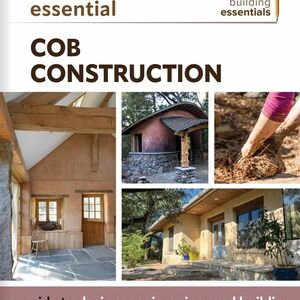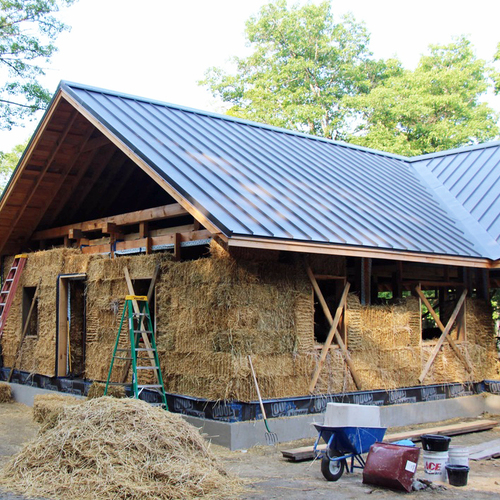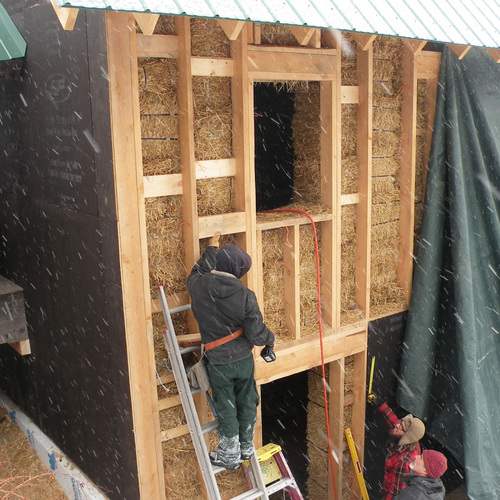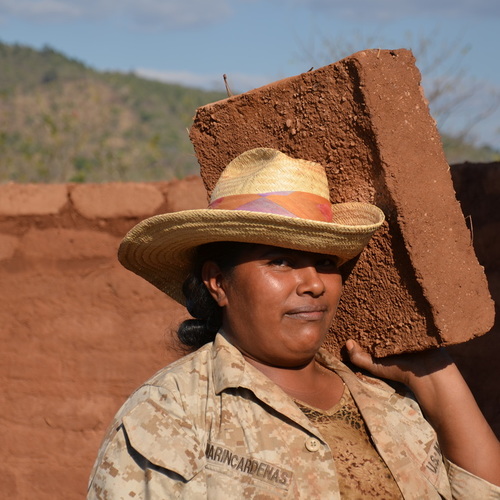
There are two camps in the green building world. One camp — the one focusing on energy efficiency — gets most of the world’s attention. The other camp — natural builders who favor materials like mud, straw, and sticks — usually gets short shrift.
My roots are firmly in the natural building community. When I was a poor hippie in the 1970s, I built a house from materials I gathered in the woods or found at the dump. Most of my Vermont friends were doing the same thing back then.
In my opinion, today’s green builders need to pay attention to natural builders. In most cases, a small cob-walled house with hand-split cedar shake roofing has a much smaller carbon footprint than a typical zero-energy home. (For an extended discussion of the split in the green building community, see “Low-Road Buildings Are Homeowner-Friendly.”)
At GBA, I’ve tried (and mostly failed) to highlight the accomplishments of natural builders. In my attempts, I’ve swum against the tide: most of the questions posted by GBA readers concern energy efficiency, not the use of natural materials.
With that background in mind, I’m happy to take this opportunity to recommend a book, Mudgirls Manifesto, that focuses on natural building. (Mudgirls Manifesto is available from New Society Publishers for $19.50.)
Changing the world
If you look at American residential builders who are now in their 60s and 70s, you’ll find that a large percentage of this group started out as hippie builders. The cohort of hippie builders who began working in the late 1960s and 1970s created many cultural ripples: for example, we were largely responsible for the success of Fine Homebuilding magazine and the Journal of Light Construction.
As part of the counterculture, many of us were unapologetically out to change the world. Looking…
Weekly Newsletter
Get building science and energy efficiency advice, plus special offers, in your inbox.

This article is only available to GBA Prime Members
Sign up for a free trial and get instant access to this article as well as GBA’s complete library of premium articles and construction details.
Start Free TrialAlready a member? Log in















12 Comments
Having had experience building cob structures and earthships, your article has me questioning why my current build is 2x6+plywood+roxul... one reason is that we are very interested in exploring how to bootstrap existing trades into efficient buildings. another is that my home is quite prominent in a small village, and the building inspector doesn't have much else to pay attention to. there is an advantage in everything looking "normal" even though under the hood we are certainly pushing the boundary on some esoteric code provisions. here in the "city" it's difficult to survive without a valid C.O. (certificate of occupancy) and it would be difficult to get a (c.o.) without following at least broad swaths of the code.
Ethan,
You wrote, "My home is quite prominent in a small village, and the building inspector doesn't have much else to pay attention to. ... Here in the 'city' it difficult to survive without a valid C.O. (certificate of occupancy) and it would be difficult to get a C.O. without following at least broad swaths of the code."
Right. Seems like a no-brainer: for your house, 2x6s, plywood sheathing, and mineral wool make sense.
These days, there are a lot fewer communities in North America where the approach adopted by hippies in 1970 is still possible -- for better or worse, depending on your personal opinion.
Martin,
Thanks for sharing your enthusiasm about this book, and of building with natural materials. I’m thinking this would be a great book to bring home for my daughters.
Although such buildings cannot be permitted or built according to code in most locations, these methods could be still be used for projects like garden walls, outdoor ovens, etc. Those are such fun projects for the whole family, and can really compliment a “pretty good house”.
With that said, here in New Mexico it is not unheard of to come across a building project involving straw bale or cob as one of the primary materials. Our building codes allow for these “alternative building methods”. We have an area on our property where someday we would like to build a straw bale and timber frame workshop/studio with earthen plasters. Of course we will include a wide brimmed hat and tall boots to protect our hard work.
Best regards,
Aaron
Aaron,
The same situation you describe in New Mexico also occurs in Vermont. Many Vermont towns have no enforcement of residential building codes, and a friend of mine lives in a straw-bale house.
I know of more than a dozen owner-built homes that were built of materials scrounged from the dump or collected in the woods, and none of these homes would pass a code inspection.
Pardon my ignorance if this is no longer the case.... but my understanding is that at least in Taos County, NM, there is a code provision for "Experimental Building" (http://www.naturalbuildingcoalition.ca/Resources/Documents/Technical/taos_policy_jul_1993.pdf)
The gist of it that you must meet all health and life safety requirements and are acknowledging that you are using an experimental method - and may need to provide additional documentation.
I think this is a method that could be applied more broadly, at lease in rural areas where fire/collapse only affect building occupants.
14.7.3 NMAC, adopted 11/15/2016, includes Appendix S Strawbale Construction from the 2015 IRC. My understanding is that this would allow one to build a strawbale home in New Mexico with the all the benefits that come with permits and guidance from the building inspector. I wonder if other states also adopted Appendix S?
New Mexico has a separate statute, 14.7.4, that allows the use of earthen building materials. In my opinion it makes sense to legitimize and regulate natural or “alternative” building methods.
I toured a nice small cob structure built by the Mud Girls at an organic farm just up the road from my place. Really delightful, although the experience was tainted by being bitten quite hard by a large pig.
Both the Mud Girls and the farm bump up against the realities of our current economic model. Neither can offer the full time employment, which most people need, and rely on a semi-volunteer workforce made up of workshop participants. Good for them, and others, who manage to do something meaningful on the margins.
Great observation there, Malcolm: "Both the Mud Girls and the farm bump up against the realities of our current economic model." Not so coincidentally, around 1970 is also when bankers gave up on asset-backed money - and so the need to flood the market with ever more fossils such as crude oil was ratcheted up another few notches: All y'all "old hippies" started building as the tidal wave was just beginning to hit. https://ourworldindata.org/fossil-fuels (N.B.: fossil madness is not demand based; it's supply based.)That noted, I'm swimming in bills up to my eyelids from local craftsmen just a town north of Beacon revivifying an olde homestead with wood fiber insluation, 1x12 sheathing, locally milled pine siding, and a Phoenix humanure system among other features. Current pain point besides my wallet is watching all the PEX installed in the walls... as the mission is to activate fossil-free materials and systems throughout.
Thanks for sharing, Martin. Your message is not falling deaf ears.
I agree that there should be more emphasis on the sustainability of the materials used in construction. I am curious as to what extent green or air-dried lumber could also fall into this category (when combined with cellulose insulation)?
It seems silly that the wood used to build my new home in the mountains of New Hampshire was shipped from British Columbia. There are saw mills specializing in EWP all around me. One of them (about 1.5 hours north) is run by hydro power. Why can't I frame with this stuff? Does it warp dramatically when air dried? Is it structurally really weak?
Ironically, as much as I ponder the use of local lumber in an effort to be more sustainable, the MudGirls are surrounded by high quality lumber and yet they choose mud! So maybe I am missing something here... I'll get this book and figure it out.
Rick,
Some people do frame with green lumber. It really depends on the application how much trouble it will cause. It both shrinks and warps - and gives off it's moisture, meaning the walls need a good drying path once they are closed in. For these reasons our code precludes using lumber over a certain moisture level.
Shipping lumber long distances may not make much ecological sense, but commercial drying as practiced in BC is fairly benign. They use hog-fuel, which is the waste from the milling process, so very little additional energy is needed, and the waste would end up being burned anyway.
Rick,
In many areas of the country, building inspectors won't approve of wood framing that lacks a grade stamp. (The worry is that your 2x10 rafters or joists will be full of knots, and that the knots will be located in places that weaken the the rafters or joists.)
So if you want to build a house using lumber from a local sawmill, talk to your local building department and see if you need a grade stamp on your lumber.
If you live somewhere without code enforcement, you can certainly use lumber from a local sawmill. That's what I used to build my house. You can either frame when the lumber is green, or you can sticker it and cover it with old metal roofing and wait 6 months or a year until the lumber is dry before you use it.
As Malcolm noted, green lumber shrinks, and some species twist. Study up before you decide to go this route.
For more information, see these articles:
"Lumber from a Bandsaw Mill"
"A Visit to the Local Sawmill"
Malcolm, Martin- Thanks a lot for the info. Very helpful, as always!
Log in or become a member to post a comment.
Sign up Log in